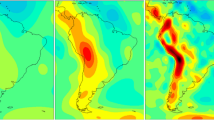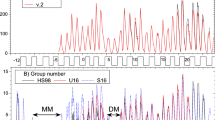Summary
A new multispectral method to derive sea surface emissivity and temperature by using interferometer measurements of the near surface upwelling radiation in the infrared window region is presented. As reflected sky radiation adds substantial spectral variability to the otherwise spectrally smooth surface radiation, an appropriate estimate of surface emissivity allows the measured upwelling radiation to be corrected for the reflected sky component. The remaining radiation, together with the estimated surface emissivity, yields an estimate of the sea surface temperature. Measurements from an ocean pier in the Baltic Sea in October 1995 indicate an accuracy of about 0.1 K for the sea surface temperature thus derived. A strong sea surface skin effect of about 0.6 K is found in that particular case.
Zusammenfassung
Eine neue multispektrale Methode zur Bestimmung von EmissivitÄt und Temperatur der MeeresoberflÄche wird vorgestellt. Die Methode basiert auf spektral hochauflösenden Interferometermessungen der von der MeeresoberflÄche aufwÄrts gerichteten Strahlung im infraroten atmosphÄrischen Fensterbereich. Die abwÄrts gerichtete Himmelsstrahlung, die an der MeeresoberflÄche reflektiert wird, überlagert dem glatten Spektrum der MeeresoberflÄchenemission eine charakteristische spektrale Struktur. Daran kann die spektrale EmissivitÄt der MeeresoberflÄche abgeschÄtzt werden. Damit wird die Korrektur der gemessenen aufwÄrts gerichteten Strahlung und folglich die Bestimmung der MeeresoberflÄchentemperatur möglich. Messungen von einer Seebrücke an der Ostsee im Oktober 1995 zeigen eine absolute Genauigkeit der so ermittelten OberflÄchentemperatur von 0,1 K. Dabei konnte ein Fall mit einem stark ausgeprÄgten Skineffekt von 0,6 K erfa\t werden.
Similar content being viewed by others
References
Alpers, W., H.-J. C. Blume, W. D. Garrett, H. Hühnerfuss, 1982: The effect of monomolecular films on the microwave brightness temperature of the sea surface.Int. J. Remote Sensing,3, 457–474.
Barton, I.J., A. J. Prata, andR. P. Cechet, 1995: Validation of the ATSR in Australian waters.J. Atmos. Oceanic Technol.,12, 290–300.
Coppin, P. A., E. F. Bradley, I. J. Barton, J. S. Godfrey, 1991: Simultaneous observations of sea surface temperature in the western equatorial pacific ocean by bulk, radiative and satellite methods.J. Geophys. Res.,96, 3401–3409.
Donlon, C. J., I. S. Robinson, 1996: Observations of the oceanic thermal skin in the Atlantic ocean, unpublished paper.
Fiedler, L., 1996: Bestimmung des WÄrmeflusses an der GrenzflÄche Luft-Wasser mittels FTIR-Spektrometrie, Diplomarbeit im Fach Meteorologie, UniversitÄt Hamburg.
Friedmann, D., 1969: Infrared characteristics of ocean water (1.5-15 Μ).Appl. Opt.,8, 2073–2078.
GESAMP (IMO / FAO / Unesco-IOC / WMO / WHO / IAEA / UN / UNEP) Joint Group of Experts on the Scientific Aspects of Marine Environmental Protection, 1995: The sea surface microlayer and its role in global change. Rep. Stud. GESAMP, 59.
Grabl, H. andH. Hinzpeter, 1975: The cool skin of the ocean, GATE Report 14, Vol. I, WMO. Geneva, 229–236.
Grabl, H., 1976: The dependence of the measured cool skin of the ocean on wind stress and total heat flux.Boundary-Layer Meteorol.,10, 465–474.
Hasse, L., 1971: The sea surface temperature deviation and the heat flow at the sea-air interface.Boundary-Layer Meteorol.,1, 368–379.
Hollweg, H.-D., 1989: Line-by-line model for the calculation of infrared radiation fluxes and the cooling rates in clear sky atmospheres, Max-Planck-Institut für Meteorologie, Report No. 36.
Jarvis, N.L., 1962: The effect of monolayer films on surface temperature and convective motion at the water/air interface.J. Colloid Sci.,17, 512–522.
Katsaros, K.B., 1980: The aqueous thermal boundary layer.Boundary-Layer Meteorol.,18, 107–127.
Kelly, C. S., 1978: Effective infrared optical depths associated with the clear ocean.Appl. Opt.,17, 3054–3059.
Masuda, K., T. Takashima, andY. Takayama, 1988: Emissivity of pure and sea waters for the model sea surface in the infrared window regions.Remote Sensing of Environment,24, 313–329.
McAlister, E.D. undW. McLeish, 1970: A radiometric system for airborne measurement of the total heat flow from the sea.Appl. Opt.,9, 2697–2705.
McKeown, W., F. Bretherton, H.L. Huang, W.L. Smith andH.L. Revercomb, 1995: Sounding the skin of water: sensing air-water interface temperature gradients with interferometry.J. Atmos. Oceanic Technol.,12, 1313–1327.
Paulson C. A. andJ.J. Simpson, 1981: The temperature difference across the cool skin of the ocean.J. Geophys. Res.,86, 11044–11054.
Revercomb, H.E., H. Buijs, H.B. Howell, D.D. Laporte, W. L. Smith andL. A. Sromovsky, 1988: Radiometric calibration of IR Fourier transform spectrometers: Solution to a problem with High-Resolution Interferometer Sounder.Appl. Opt.,27, 3210–3218.
Robinson, I. S., N. C. Wells andH. Charnock, 1984: The sea surface thermal boundary layer and its relevance to the measurement of sea surface temperature by airborne and spaceborne radiometers.Int. J. Remote Sensing,5, 19–45.
Saunders, P.H., 1967: The temperature at the ocean-air interface.J. Atmos. Sci.,24, 269–273.
Savitzky, A. andM.J.E. Golay, 1964: Smoothing and differentiation of data by simplified least squares procedures.Analyt Chem.,36, 1627–1639.
Schlüssel, P., 1995: Passive Fernerkundung der unteren AtmosphÄre und der MeeresoberflÄche aus dem Weltraum, Berichte aus dem Zentrum für Meeres- und Klimaforschung, Reihe A, Nr. 20.
Schlüssel, P., W.ü. Emery, H. Grabl andT. Mammen 1990: On the bulk-skin difference and its impact on satellite remote sensing of the sea surface temperature.J. Geophys. Res.,95, 13341–13356.
Sidran, M., 1981: Broadband reflectance and emissivity of specular and rough water surfaces.Appl. Opt.,20, 3176–3183.
Smith, W.L., R.O. Knuteson, H.E. Revercomb, W. Feltz, H.B. Howell, W.P. Menzel, N. Nalli, O. Brown, J. Brown, P. Minnett, W. McKoewn, 1996: Observations of the infrared radiative properties of the ocean — implications for the measurement of sea surface temperature via satellite remote sensing.Bull. Amer. Meteorol. Soc.,77, 41–51.
Thomas, J.P., J. Knight, H.K. Roscoe, J. Turner andC. Symon, 1995: An evaluation of a self-calibrating infrared radiometer for measuring sea surface temperature.J. Atmos. Oceanic Technol.,12, 301–316.
Timofeev, Yu.M., 1966: Thermal sounding of surface water layers by means of thermal radiation.Izv. Atm. Oceanic Phys.,2, 467–469.
Author information
Authors and Affiliations
Corresponding author
Rights and permissions
About this article
Cite this article
Fiedler, L., Bakan, S. Interferometric measurements of sea surface temperature and emissivity. Deutsche Hydrographische Zeitschrift 49, 357–365 (1997). https://doi.org/10.1007/BF02764044
Received:
Accepted:
Issue Date:
DOI: https://doi.org/10.1007/BF02764044




